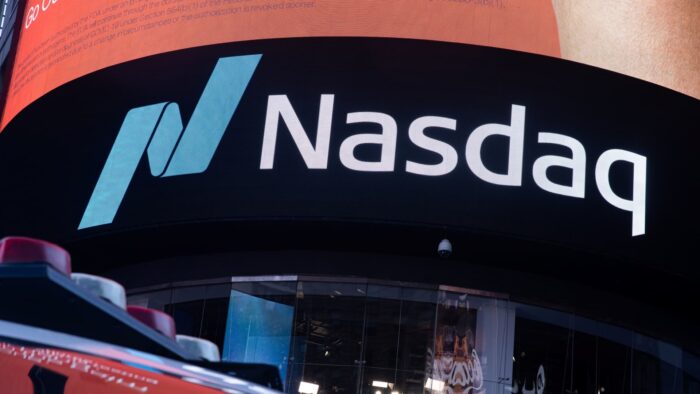
Nasdaq (NDAQ) recently made a significant move to expand its presence in the financial technology sector through the acquisition of Adenza, a software firm owned by Thoma Bravo, a prominent private equity company. This groundbreaking deal, regarded as Nasdaq’s largest-ever transaction, sent shockwaves through the market, leading to a drop in share prices following the announcement.
The Acquisition Deal
Under the terms of the agreement, Nasdaq revealed its commitment to purchase Adenza for an impressive sum of $10.5 billion, combining cash and stock. Adenza specializes in providing cutting-edge risk management and regulatory software solutions tailored specifically for the financial industry.
In this deal, Thoma Bravo, the parent company of Adenza, will receive $5.75 billion in cash along with 85.6 million shares, thereby securing a 14.9% stake in Nasdaq. Additionally, Nasdaq intends to expand its board to 12 members and appoint Holden Spaht, the Managing Partner at Thoma Bravo, to a key position on the board.
The Significance of the Acquisition

Nasdaq’s CEO, Adena Friedman, expressed her excitement about this strategic move, referring to it as an “exceptional opportunity” that will enhance Nasdaq’s position as a central player in the global financial system. With the acquisition of Adenza, Nasdaq aims to strengthen its capabilities and broaden its offering to clients operating within the financial sector.
Tal Cohen, the President of Marketing Platforms at Nasdaq, highlighted the increasing compliance costs faced by banks since the implementation of Dodd-Frank rules in 2010. These costs have surged beyond $50 billion per year. Cohen emphasized that by integrating Adenza’s suite of software and technology solutions, Nasdaq aims to simplify and streamline risk management and regulatory compliance for its clientele.
Expected Timeline
Nasdaq foresees the completion of the acquisition within the next six to nine months. This timeline allows for the necessary regulatory approvals and due diligence required for such a substantial transaction.
Market Impact
The news of Nasdaq’s acquisition of Adenza had an immediate effect on the market, as Nasdaq’s shares experienced a sharp decline of 12% as of 11:20 a.m. Eastern Time on Monday. This drop brought the shares to their lowest point for the year, reflecting investor sentiment and reaction to the news.
NASDAQ Past Aquisitions
NASDAQ, the renowned global electronic marketplace for buying and selling securities, has a rich history of strategic acquisitions. These acquisitions have played a pivotal role in expanding NASDAQ’s reach, diversifying its offerings, and solidifying its position as a leader in the financial industry. In this article, we explore some notable past NASDAQ acquisitions that have shaped the organization and influenced the markets.
1. OMX Group (2008)

In 2008, NASDAQ completed its acquisition of OMX Group, a leading provider of exchange technology and services. This transformative $3.7 billion deal allowed NASDAQ to expand its global footprint and establish a strong presence in Europe. By acquiring OMX Group, NASDAQ gained access to advanced trading platforms, clearing services, and market surveillance capabilities, strengthening its position as a premier technology provider in the financial markets.
2. eSpeed (2013)
NASDAQ’s acquisition of eSpeed in 2013 marked a significant move into the fixed-income market. eSpeed, an electronic trading platform for U.S. Treasury bonds and other fixed-income securities, brought NASDAQ valuable expertise and technology in this specialized sector. With this $750 million acquisition, NASDAQ diversified its product offerings and expanded its presence in the bond market, catering to the evolving needs of its clients and further cementing its status as an innovative exchange operator.
3. International Securities Exchange (ISE) (2016)
In 2016, NASDAQ acquired International Securities Exchange (ISE), one of the largest options exchanges in the U.S. This $1.1 billion transaction bolstered NASDAQ’s options trading capabilities and extended its market share in the derivatives space. By integrating ISE’s technology and expertise, NASDAQ enhanced its ability to provide a comprehensive suite of trading solutions to investors, further strengthening its position in the competitive options market.
4. Dorsey Wright & Associates (2015)
NASDAQ expanded its portfolio of financial services with the acquisition of Dorsey Wright & Associates (DWA) in 2015. DWA is a leading provider of technical analysis and research solutions for investment advisors. Through this strategic $225 million deal, NASDAQ augmented its offerings in the realm of data analytics and investment strategies. By incorporating DWA’s innovative tools and insights, NASDAQ empowered its clients with advanced research capabilities and actionable investment intelligence.
Trading the NASDAQ

Trading NASDAQ, the renowned global electronic marketplace, or considering investments in companies like Adenza, requires careful planning and strategic decision-making. This guide aims to provide insights and strategies to help traders navigate the complexities of trading NASDAQ or investing in Adenza, optimizing their chances for success in the dynamic financial landscape.
1. Understanding NASDAQ and Adenza:
Before initiating any trading activity, it’s crucial to develop a comprehensive understanding of the NASDAQ exchange and Adenza as a company. Research the history, operations, and financial performance of NASDAQ-listed companies, keeping a close eye on Adenza’s risk management and regulatory software solutions. Familiarize yourself with the market trends, industry dynamics, and any recent news or developments impacting these entities.
2. Develop a Trading Plan:
Creating a well-defined trading plan is essential to manage risk and increase the potential for profits. Determine your investment goals, risk tolerance, and preferred trading style (e.g., day trading, swing trading, long-term investing). Specify the amount of capital you are willing to invest and establish clear entry and exit points for trades. Your trading plan should also include risk management strategies, such as stop-loss orders and position sizing techniques, to protect against potential losses.
3. Technical and Fundamental Analysis:
Utilize both technical and fundamental analysis to make informed trading decisions. Technical analysis involves studying price patterns, chart indicators, and market trends to identify entry and exit points. Apply various technical analysis tools, such as moving averages, support and resistance levels, and oscillators, to gain insights into the market’s behavior. Additionally, conduct fundamental analysis by evaluating Adenza’s financial statements, industry trends, competitive landscape, and any regulatory factors influencing the NASDAQ market.
4. Stay Informed:
Stay abreast of relevant news, economic indicators, and market events that could impact NASDAQ or Adenza. Subscribe to financial news platforms, follow reputable analysts, and leverage market data and research tools to gain timely information and insights. Develop a habit of monitoring company announcements, earnings reports, and regulatory changes that may affect the stock prices of NASDAQ-listed companies or Adenza.
5. Risk Management:
Successful trading involves effective risk management. Never risk more than you can afford to lose on any single trade or investment. Implement proper position sizing techniques to ensure that losses on individual trades do not have a significant impact on your overall portfolio. Consider using stop-loss orders to automatically exit positions if the trade moves against you. Diversify your investments across different sectors and asset classes to mitigate risk and reduce exposure to a single company or industry.
6. Continuous Learning and Adaptation:
Trading NASDAQ or investing in Adenza requires ongoing learning and adaptation. Stay open to new strategies, techniques, and market insights. Track patterns or strategies that have worked well with brokers in the UK.

Future of NASDAQ
The Nasdaq acquisition of Adenza marks a significant milestone in Nasdaq’s expansion into the financial technology sector. With a massive investment of $10.5 billion, Nasdaq aims to leverage Adenza’s expertise and software solutions to enhance its position as a leading player in the global financial system. While the market responded with a decline in share prices, the long-term implications of this strategic move have yet to fully unfold. As the transaction progresses, the financial industry and market participants will closely monitor Nasdaq’s integration of Adenza’s capabilities and how it shapes the future of financial technology.
NASDAQ’s history of acquisitions showcases its commitment to growth, innovation, and diversification. These strategic moves have allowed NASDAQ to expand its geographical presence, diversify its product offerings, and strengthen its technological capabilities. Through acquisitions such as OMX Group, eSpeed, ISE, and DWA, NASDAQ has positioned itself as a dynamic force in the financial industry, offering a comprehensive range of services to meet the evolving needs of market participants. As NASDAQ continues to evolve, we can anticipate further strategic acquisitions that will shape the future of the financial markets and solidify NASDAQ’s position as a leader in the global exchange landscape.





![Personal Insolvency: Steps to Rebuild Your Financial Health [UK]](https://www.chartsattack.com/wp-content/uploads/2024/07/Personal-Insolvency-1-218x150.jpg)










